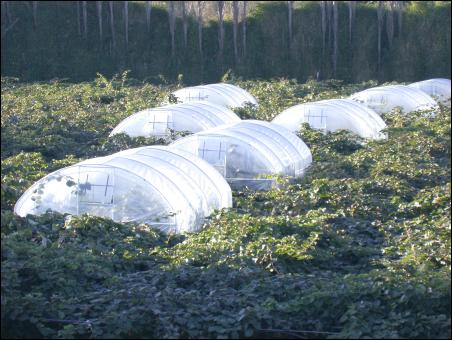Better tasting kiwifruit
Better tasting kiwifruit
Taste is everything
Hayward (or green) kiwifruit taste better if they have high dry matter content. The better the taste the more consumers want to buy them and growers receive a premium for fruit that meets the Taste ZESPRITM Dry Matter Index.

This season growers and packhouses have been requested to ensure that as much Taste ZESPRITM kiwifruit as practicable is exported to Japan and East Asia.
Therefore it makes sense to do research to find out just what does increase dry matter in kiwifruit. A project underway at HortResearch Te Puke has seen eight tunnel houses erected in a standard orchard block. Scientist Bill Snelgar said the model they are using is based on climate and the experiment is to test some aspects of the model by changing temperature at various times of the year.
Looking like rows of igloos the eight "small" tunnel houses each completely cover a whole vine in a standard orchard block. The greenhouses come in pieces and are assembled around the selected vines. Each greenhouse has a stand-alone control unit. They were installed for two-month periods prior to flowers, in summer, and in autumn.
The greenhouse temperatures are monitored continuously by datalogger. Dr Snelgar has organised a lead from greenhouses to his office to download data and monitor performance. As they need to be checked at least every second day he takes a portable PC home and phones them on weekends, or even from motels if on holiday. Now that is dedication.
So far they have found that warm springs increase shoot growth and fruit size while warm summers increase shoot growth at the expense of fruit size.
Fruit from these vines will also be used to look at low temperature breakdown and pitting, the Vitamin C content will be assessed as will variations in the acidity and sugars, and a PhD student has been following canopy development of the vines.
"But our main interest will be in the DM at harvest," Dr Snelgar said.
The project has been funded by the Foundation for Research, Science and Technology.


 Citizens of the Sea: Sailors To Revolutionise Our Understanding Of Pacific Biodiversity
Citizens of the Sea: Sailors To Revolutionise Our Understanding Of Pacific Biodiversity Netsafe: Making A Splash With Online Safety: Netsafe Launches New Flagship Programme For Kids
Netsafe: Making A Splash With Online Safety: Netsafe Launches New Flagship Programme For Kids NZGBC: Flood Resilience PhD Student Widi Auliagisni Named Future Thinker Of The Year 2024
NZGBC: Flood Resilience PhD Student Widi Auliagisni Named Future Thinker Of The Year 2024 Business Canterbury: European Free Trade Agreement A Game-changer For Canterbury
Business Canterbury: European Free Trade Agreement A Game-changer For Canterbury Business Canterbury: Urges Council To Cut Costs, Not Ambition For City
Business Canterbury: Urges Council To Cut Costs, Not Ambition For City Wellington Airport: On Track For Net Zero Emissions By 2028
Wellington Airport: On Track For Net Zero Emissions By 2028



